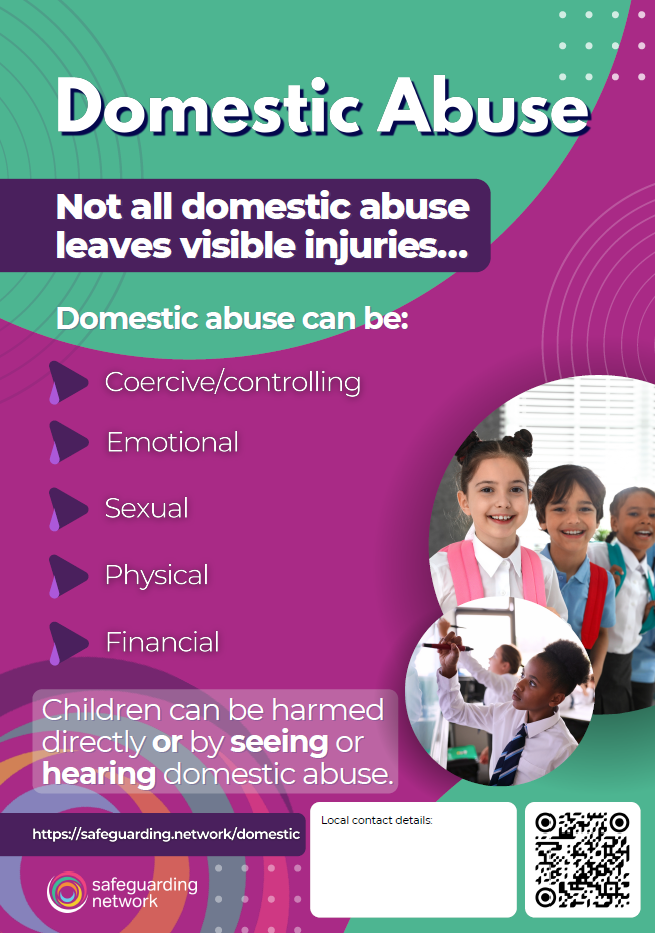Introduction
Many children in Britain live with domestic abuse. The consequences can be wide-ranging, as well as exposing children to physical and emotional harm. They see parents or carers suffer, often at the hands of someone else they love. They can suffer physical, sexual and emotional abuse themselves. Sometimes they are forced into colluding with the violent parent or carer; sometimes they feel deeply responsible for the non-abusing parent or carer, or their siblings. Some children experience domestic abuse from their own intimate partner.
Need more?
Thank you for visiting our resources pages. These are free to everyone as is our fortnightly safeguarding bulletin – general safeguarding information is too important to restrict. Become a member to access lots more, including training materials for you to deliver in-house on each topic in Keeping Children Safe in Education.
Sign up for FREE fortnightly bulletin.
What about training?
We can deliver training for your setting on this and other subjects via online platforms, or face-to-face in certain areas. Just get in touch to discuss your requirements.
The impact of violence and abuse can be devastating. Many victims suffer physical harm, which can be fatal in extreme cases. Death may result from violence or through suicide because the abuse and subsequent mental illness have made the victims life difficult to bear. Other victims may lose their homes, be unable to hold down a job or a relationship and/or become isolated from friends and family. Children may also be at risk, either by witnessing abuse of others or by being victims of abuse themselves.
Children can be further affected when adult victims of domestic abuse sometimes find it difficult to be the caring, supportive parents they want to be, even after leaving the abusive relationship, because they have been hurt and traumatised by their experiences.
Always ask yourself – “What’s it like to be a child living in that household?”
Definition of domestic abuse
Domestic abuse is any incident or pattern of incidents of controlling, coercive, threatening behaviour, violence or abuse between those aged 16 or over who are “personally connected” and the behaviour is abusive. Abuse can be direct or indirect (e.g., through a child). Children can be victims if they are related and see, hear or experience the abuse.
Adapted from the Domestic Abuse: Statutory Guidance
Domestic abuse is more than physical
Domestic abuse is not just physical violence, hence the move from talking about domestic violence to talking about domestic abuse. Many people experiencing violence report the psychological and emotional impact as having a greater impact, while others are manipulated and abused without physical violence. All of these experiences have an impact on children and young people.
Domestic abuse also falls within wider Violence Against Women and Girls (VAWG) and Adolescent to Parent Violence and Abuse (APVA) strategies.
According to the Royal College of Psychologists, in relationships where domestic abuse occurs, approximately three-quarters of the abusive incidents are witnessed by children. Around half of the children in these families have also experienced being badly hit or beaten themselves. Additionally, the likelihood of sexual abuse and emotional abuse occurring in these households is significantly higher.
Statistics
- The National Centre for Domestic Violence says 1-in-5 adults experience domestic abuse during their lifetime. This equates to 1-in-4 women and 1-in-7 men.
- The Crime Survey for England and Wales estimated that 2.1 million people aged 16 years and over (1.4 million women and 751,000 men) experienced domestic abuse in the year ending March 2023.
- According to Foundations, at least 827,000 children in England and Wales may have suffered due to domestic abuse in 2023.
- SafeLives says 78% of children living with domestic abuse are directly harmed by the perpetrator of the abuse, in addition to the harm caused by witnessing the abuse of others.
We know that there is a high degree of under-reporting from both males and females, which is linked to different factors, including shame, blaming themselves for their partner’s behaviour and believing that it is an inherent part of the relationship. This means that accurate figures are likely to be significantly higher.
SafeLives suggests that in the UK, on average, victims will live with domestic abuse for around 3 years before getting help. Domestic abuse and sexual violence can be persistent with the highest repeat victimisation of any crime.
According to government statistics on children in need in England, concerns about the parent/carer being the victim of domestic abuse remained one of the most common factors identified by social worker at the end of assessments in the year to 31 March 2023, with it being identified in just under one third of episodes with assessment factors recorded.
Impact on children and young people
Mental health - Children exposed to domestic abuse often experience intense feelings of fear, anxiety, and helplessness. This can lead to symptoms of post-traumatic stress disorder (PTSD), depression and anxiety. They may also struggle with mood swings, sleep disturbances and issues with self-esteem and self-worth.
Social development - Many children may struggle to form healthy relationships and trust others because their understanding of interpersonal relationships has been shaped by dysfunction and violence. This may include displaying aggressive, antisocial or defence behaviours, due to internalising the violent dynamics they have witnessed.
Academic performance - The stress and trauma associated with domestic abuse can impair a child's ability to concentrate, problem-solve and learn. This can lead to long-term educational challenges and hinder their prospects.
Perpetuating the cycle - children who have been exposed to domestic abuse can be at a higher risk of perpetuating or becoming victims of abuse themselves in their adult lives. This could perpetuate the cycle of violence and has broader societal implications.
Spot the signs
Children or young people may:
- be wary of adults
- be aggressive, act out witnessed events
- have difficulty concentrating
- have difficulty developing relationships
- reduce attendance at education and/or attainment
- develop an eating disorder
- have poor self-esteem, depression or anxiety
- self-harm
- misuse alcohol or other substances
- develop concerning relationships.
Why don’t they leave/why don’t they tell?
Abuse often gets worse over time, and many victims are manipulated into believing that they are at fault. It may also be that they:
- don’t yet recognise the abusive nature of the relationship
- don’t think they will be believed (many domestic abusers appear loving and charming to others, and/or they may be in professions linked to protection or status)
- are too scared to leave
- don’t have money or anywhere else to go
- feel isolated
- face a language/communication barrier
- struggle with pressures from their religious/rural/close community or family
- feel dependent due to age or disability
- may not wish to risk their immigration status
- worry about taking their children out of school and moving them
- no longer have the strength to leave and fear the upheaval it may cause for them and/or others
- believe/hope they can change things
- hope that the abuse will stop.
By the time the victim realises that the relationship is destructive and/or dangerous, it may seem impossible to get out.
What to do
It’s essential to provide intervention and support for children who have been impacted by domestic abuse. Early intervention and access to trauma-informed care can relieve the long-term effects of domestic abuse and help children heal. Creating a safe and supportive environment where children can express their feelings and receive appropriate therapy is essential to their recovery.
Addressing and mitigating the effects of domestic abuse on children requires a comprehensive approach that encompasses mental health support, education and collaboration with external agencies.
Prevention
- Ensure all staff understand and can apply the wider definition of domestic abuse. We offer a challenging e-learning package that is relevant to anyone working in education for £10 + VAT per person (£2.99 + VAT for Safeguarding Network members). Click here to find out more.
- Work on relationships through PHSE but also through a wider promotion of gender equality across the setting, including equality in same-sex relationships. This links closely with education about bullying.
- Create discussions and opportunities to reflect on developing relationships between young people.
- Raise awareness of domestic abuse among children and young people. Ensure children and young people know who to talk to if they are worried and carry out peer-to-peer work to ensure teaching about safety in relationships is supported by a culture that reaches beyond the setting.
Response
If you have concerns about domestic abuse in a child’s home a multi-agency approach is necessary.
- Report all concerns to your DSL. If there is a risk of immediate harm call the police.
- Provide practical, age-appropriate help for the child with safety planning.
- Consider what support you can provide to the victim of abuse.
- Where appropriate to your role, don’t neglect to work with the abuser if it’s safe to do so. If it’s not safe to work with the abuser, is it safe for the child?
- Try to understand the factors that make abuse more likely but hold a clear value base that does not blame the victim.
- Seek therapeutic support to help the child deal with feelings of blame and guilt, and to understand healthy relationships, abusive behaviour and how conflict can be resolved in a positive way.
- Provide other relevant interventions around the child based on their risk and need – refer to your local safeguarding partnership threshold tool.
Take action - and keep taking action until you know children and young people are safe.
Free domestic abuse poster
This free, downloadable resource raises the profile of safeguarding for your staff team. For use in staff rooms, on safeguarding boards or on the back of toilet doors, the poster includes tips, a space for local contact details, plus a link and QR codes to this resource page. Download the poster from the resources below.
DSL Training Materials
-

Presentation: Domestic abuse
-

Domestic Abuse - Presenter Notes
-

Expect Respect Healthy Relationships Toolkit
-

Handout for staff - Domestic Abuse
-

Introduction to Domestic Abuse e-learning
-

Domestic Abuse – Quiz
-

Domestic Abuse – Quiz (answers)
-

Domestic Abuse Scenario – Early years settings
-

Domestic Abuse Scenario – Early Years settings – DSL Information Sheet
-

Domestic abuse scenario (primary schools)
-

Domestic abuse scenario (primary schools) – DSL information sheet
-

Domestic abuse scenario (secondary schools)
-

Domestic abuse scenario (secondary schools) – DSL information sheet
-

Domestic Abuse Scenario – 16+ settings
-

Domestic Abuse Scenario – 16+ settings – DSL Information Sheet
-

Domestic Abuse Scenario – SEND Settings
-

Domestic Abuse Scenario – SEND Settings – DSL Information Sheet
-

Domestic Abuse Scenario – care settings
-

Domestic Abuse Scenario – Care settings – DSL Information Sheet
Resources
-

Domestic Abuse Poster
-

Women’s Aid – downloads and resources
-

Children and young people Insights dataset
-

Operation Encompass
-

Introduction to Domestic Abuse e-learning
-

“Are they shouting because of me?”
-

Coercive control: ‘I was 16 and thought it was normal’ – BBC video
-

CPV – Child to Parent Violence
-

CPV Information – Family Lives
-

Spotlight: The podcast for the domestic abuse sector
-

Ask Ani - Postcode Checker
-

For Baby’s Sake
Save time and improve your safeguarding approach…
Bite-size training materials to share with your staff every month.
Support to explore and develop your safeguarding culture.
A huge array of resources and professional experience at your fingertips.
Get in touch now for a personal tour of the site and details of membership benefits.
We look forward to working with you.


